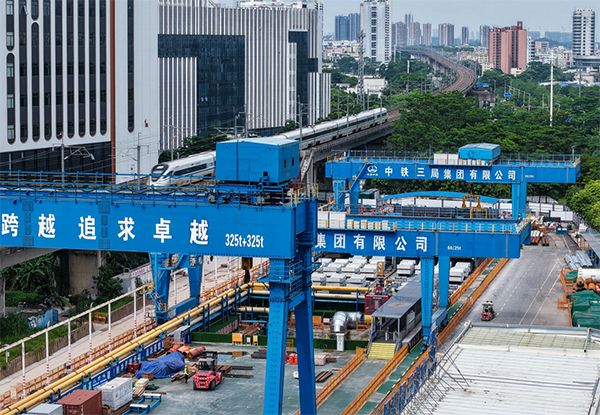 Local News
Local News
The construction site of the Pingshan East Tunnel in Pingshan District. Photos by Xinhua unless otherwise stated
Recently, construction advanced on three major rail lines affecting Pingshan District: the Shenzhen-Shenshan High-speed Railway, the Shenzhen-Daya Bay Intercity Rail, and the Dapeng branch of the Shenzhen-Huizhou Intercity Railway. Once completed, these lines will significantly shorten travel times from Pingshan to Shenshan, the Shenzhen airport, and Dapeng New Area.
Shenzhen-Shenshan High-speed Railway
On Aug. 1, the 14.34-meter-diameter slurry tunnel boring machine (TBM) named “Pingshan East No. 3” began tunneling on Section 4 of the Shenzhen-Shenshan High-speed Railway.
Section 4 runs between Pingshan District and Huizhou’s Daya Bay area and encounters highly complex ground conditions. The alignment runs parallel to the existing Xiamen-Shenzhen railway, with a minimum separation of just 8.6 meters, creating stringent requirements for surface-settlement control and precise TBM attitude management.
“Pingshan East No. 3” is equipped with an advanced synchronized thrust-and-segment-assembly system and a suite of intelligent technologies, ensuring safe, efficient excavation in difficult geology.

A technician checks the “Pingshan East No. 3” tunnel boring machine.
On Aug. 11, at 60 meters below Danzi Boulevard in Pingshan District, the sister TBM “Pingshan East No. 4” (also 14.34 meters in diameter) achieved 500 rings and a cumulative advance of one kilometer.
Achieved beneath complex ground immediately adjacent to an existing high-speed railway bridge, this milestone both advances the schedule and validates the project’s stringent safety and risk-management protocols.
Both TBMs are excavating the Pingshan East Tunnel, a key part of the Shenzhen-Shenshan line. The tunnel is 27.885 km long, single-bore and double-track, and is designed for speeds up to 350 km/h.
The Shenzhen-Shenshan High-speed Railway will be 125.5 km long and will include six stations: Xili, Luohu North and Pingshan in Shenzhen, Huiyang and Huidong South in Huizhou, and Shenshan Station in the Shenshan Special Cooperation Zone. Upon expected completion in 2027, travel time between downtown Shenzhen and Shenshan will be about 30 minutes, with an even shorter trip from Pingshan.

The “Pingshan East No. 4” tunnel boring machine. Photo from China Railway No. 3 Engineering Group Co. Ltd.
Shenzhen-Daya Bay Intercity Rail
On July 15, the Pingnan Railway track realignment near Wuhe Station for the Shenzhen-Daya Bay Intercity Rail was completed. The temporary diversion, which involved relocating infrastructure onto the temporary alignment, was carried out to facilitate and protect the intercity rail construction. As a critical phase of the project, the operation was highly complex, involved significant risks, and required intensive multi-party coordination.
The Shenzhen section of the Shenzhen-Daya Bay Intercity Rail starts at Terminal 4 of Shenzhen Bao’an International Airport, passes through Bao’an, Longhua and Longgang districts, and ends at Julong Station in Pingshan. The section is about 69.2 km long, with a design speed of 160 km/h, and includes 11 underground stations: T4 Hub, Airport East, Huangmabu, Shiyan Center, Longsheng, Minzhi North, Wuhe, Bainikeng, Universiade, Pingshan and Julong.
When the line opens, expected in 2026, travel time from Pingshan to the Shenzhen airport could be as short as 40 minutes. The line will also strengthen rapid links across Shenzhen and improve regional connectivity in the Guangdong-Hong Kong-Macao Greater Bay Area and the Shenzhen-Dongguan-Huizhou metropolitan circle.
Dapeng branch of the Shenzhen-Huizhou Intercity Railway
On Aug. 10, a TBM tunnel between Longping Work Shaft No. 1 and Work Shaft No. 2 on the Dapeng branch of the Shenzhen-Huizhou Intercity Railway was completed. This project is the first in China to adopt a fully automated belt-conveyor spoil-removal system for TBM muck transport in a launch section.
The interval between the two shafts is 3 km long — the longest on the Dapeng branch — and the tunnel has a maximum burial depth of 115 meters. To mitigate risks in the extremely adverse ground conditions, the project team deployed advanced methods: InSAR satellite monitoring for macroscopic deformation, microseismic detection to identify concealed geology, automated water-level monitoring for hydrological tracking, and muon detectors installed inside the tunnel for structural safety diagnostics.
The Dapeng branch runs from Longcheng Station in Longgang District to Xinda Station in Dapeng New Area, passing Pingshan, Yanzi Lake, Kuichong and Dapeng stations. The branch is about 39.4 km long with a design speed of 160 km/h. Upon its expected completion in 2026, travel time between Pingshan and Dapeng will be about 30 minutes.